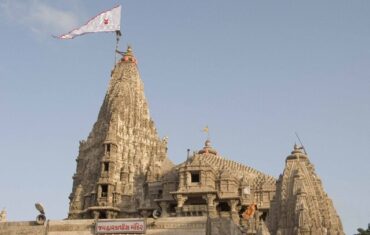Khajuraho Temples are a group of Hindu and Jain temples in Chhatarpur district, Madhya Pradesh, India. They are a UNESCO World Heritage Site and are famous for their nagara-style architectural symbolism and a few erotic sculptures. The temples were built between 885 CE and 1000 CE by the Chandela dynasty and reflect the religious and cultural diversity of the region. The temples are also known for their exquisite carvings and sculptures that depict various aspects of life, such as worship, love, war, music, dance, and nature. Visit during Khajuraho local sightseeing By cab
Khajuraho Temples Location/ Timing and Entry Fees

Khajuraho Temples are located about 175 kilometers southeast of Jhansi, 10km from Azad Nagar Khajwa, 9km from Rajnagar and 49 km from district headquarter Chhatarpur. They are spread over an area of six square kilometers and are divided into three clusters: western, eastern, and southern. The western cluster is the largest and contains the most famous temples, such as Kandariya Mahadeva Temple, Lakshmana Temple, Devi Jagadambi Temple, Chitragupta Temple, Vishvanatha Temple, and Nandi Temple. The eastern cluster contains mostly Jain temples, such as Parsvanatha Temple, Adinatha Temple, Shantinatha Temple, and Ghantai Temple. The southern cluster contains only two temples: Duladeo Temple and Chaturbhuj Temple.
The temples are open daily from sunrise to sunset. The entry fee for Indian citizens is Rs. 40 per person and for foreign nationals is Rs. 600 per person. There is no entry fee for children below 15 years of age. There is also a light and sound show every evening at the western cluster that narrates the history and significance of the temples. The show timings are 6:30 pm to 7:25 pm in English and 7:40 pm to 8:35 pm in Hindi. The ticket price for the show is Rs. 250 per person for Indians and Rs. 700 per person for foreigners.
Things to Do / Must See Khajuraho Temples

Khajuraho Temples are a must-see destination for anyone who wants to witness the artistic excellence and cultural richness of ancient India. The temples offer a visual feast of architecture and sculpture that showcase the nagara-style features, such as curvilinear spires (shikharas), ornate platforms (jagatis), interconnected spaces (mandapas), vestibules (antaralas), sanctums (garbhagrihas), circumambulatory paths (pradakshinas), projecting windows (jharokhas), and subsidiary shrines (urushringas). The temples also display a variety of sculptures that depict sacred and secular themes, such as deities, celestial beings, mythical creatures, warriors, musicians, dancers, animals, plants, erotic scenes, and geometric patterns.
Visitors can explore the temples at their own pace or take a guided tour that explains the history and symbolism of the temples. Visitors can also admire the natural beauty of the surroundings that include hills, forests, lakes, and rivers. Visitors can also participate in various cultural events and festivals that take place at the temples throughout the year, such as Khajuraho Dance Festival in February-March that showcases classical dance forms of India;
Shivaratri Festival in February-March that celebrates Shiva’s marriage to Parvati; Holi Festival in March that marks the arrival of spring with colors; Ram Navami Festival in April that commemorates Rama’s birth; Dussehra Festival in October that celebrates Rama’s victory over Ravana; Diwali Festival in November that signifies the triumph of light over darkness; and Makar Sankranti Festival in January that marks the transition of the sun into Capricorn.
How to Reach Khajuraho Temples

Khajuraho Temples can be easily reached by air, rail or road from various parts of India. The nearest airport is Khajuraho Airport (IATA Code: HJR), which is about 9 km away from the temple complex. The airport has flights to Delhi, Agra,
- A: The nearest airport is Khajuraho Airport (IATA Code: HJR), which is about 9 km away from the temple complex. The airport has flights to Delhi, Agra, Varanasi and Mumbai. From the airport, one can take a taxi or a bus to reach the temples.
- The nearest railway station is Khajuraho Railway Station, which is about 6 km away from the temple complex. The railway station has trains to Delhi, Agra, Jhansi, Bhopal and Udaipur. From the railway station, one can take a taxi or a bus to reach the temples.
- The temple complex is also well connected by road to various cities and towns in Madhya Pradesh and neighboring states. There are regular buses and taxis available from places like Jhansi, Chhatarpur, Satna, Panna, Bhopal and Indore.
Significance of Khajuraho Temples

Khajuraho Temples are one of the most significant monuments of Indian art and culture. They represent the peak of nagara-style temple architecture and sculpture that flourished under the Chandela dynasty in the 10th and 11th centuries CE. The temples reflect the religious and cultural diversity of the region, as they are dedicated to two different religions: Hinduism and Jainism.
The temples also demonstrate the artistic creativity and technical skill of the master craftsmen who carved intricate and expressive sculptures on stone surfaces. The temples also convey the worldview and values of the ancient society that celebrated life in all its aspects, including spirituality, love, war, music, dance, and nature.
The temples are also significant for their historical and archaeological value. They are rare surviving examples of nagara-style temples that were once widespread in northern India. They are also valuable sources of information about the Chandela dynasty and its patronage of art and culture. The temples also provide insights into the social and economic life of the people who lived in and around Khajuraho. The temples also reveal the influence of various regional and foreign styles and motifs on Indian art and architecture.
FAQs
Q: Who built Khajuraho Temples?
A: Khajuraho Temples were built by the Chandela dynasty, who ruled over a large part of central India from the 9th to the 13th centuries CE. The Chandelas were originally feudatories of the Pratihara empire but later became independent rulers. They were patrons of art and culture and commissioned many temples and monuments in their kingdom. The most prolific period of temple building was during the reigns of Dhanga (950-1002 CE), Ganda (1017-1029 CE), Vidyadhara (1035-1042 CE) and Kirtivarman (1060-1100 CE).
Q: Why are Khajuraho Temples famous for erotic sculptures?
A: Khajuraho Temples are famous for erotic sculptures that depict various forms of sexual union between couples. These sculptures are found mostly on the outer walls of some temples in the western cluster. They constitute about 10% of the total sculptures in Khajuraho. There are various interpretations and explanations for these erotic sculptures.
Some scholars suggest that they represent tantric practices that aim at achieving spiritual liberation through sexual energy. Some others suggest that they symbolize fertility and procreation that ensure continuity of life. Some others suggest that they illustrate kama (pleasure), one of the four goals of human life according to Hindu philosophy. Some others suggest that they serve as a contrast to dharma (duty) and moksha (salvation), which are depicted inside the temples.
Q: How many temples are there in Khajuraho?
A: The western cluster contains 14 temples, including Kandariya Mahadeva Temple, Lakshmana Temple, Devi Jagadambi Temple, Chitragupta Temple, Vishvanatha Temple, and Nandi Temple. The eastern cluster contains nine temples, mostly Jain temples, including Parsvanatha Temple, Adinatha Temple, Shantinatha Temple, and Ghantai Temple. The southern cluster contains only two temples: Duladeo Temple and Chaturbhuj Temple.
Conclusion
Khajuraho Temples are a world heritage site of nagara-style architecture and sculpture that showcase the artistic excellence and cultural richness of ancient India. The temples were built by the Chandela dynasty in the 10th and 11th centuries CE and reflect the religious and cultural diversity of the region. The temples are also known for their exquisite carvings and sculptures that depict various aspects of life, such as worship, love, war, music, dance, and nature. The temples are a must-visit destination for anyone who wants to witness the glory and beauty of Indian art and culture.










